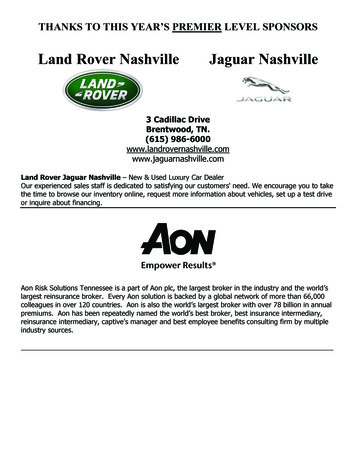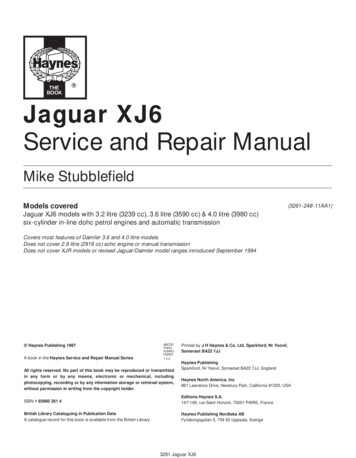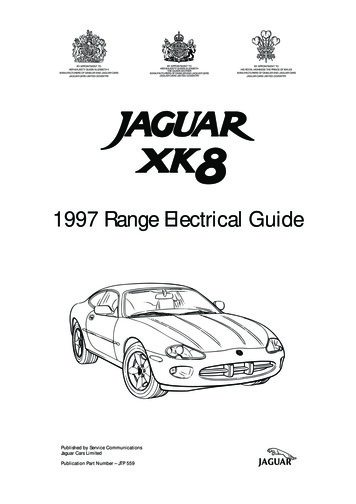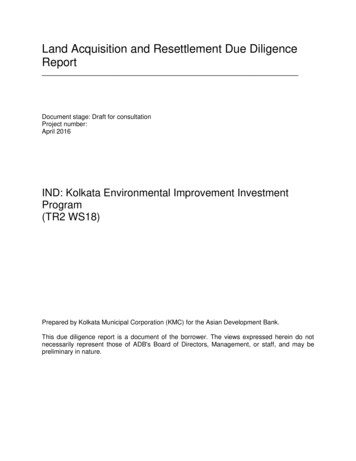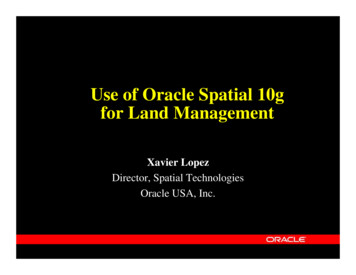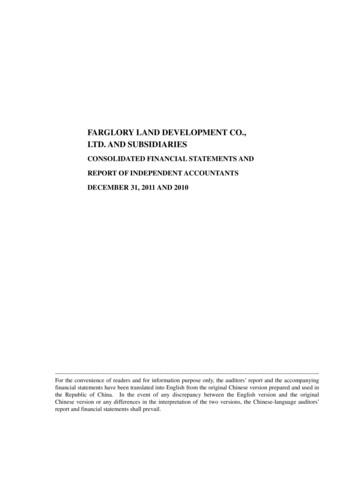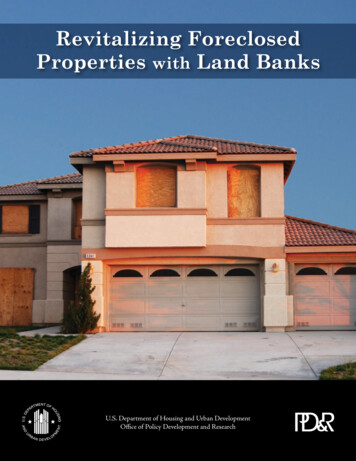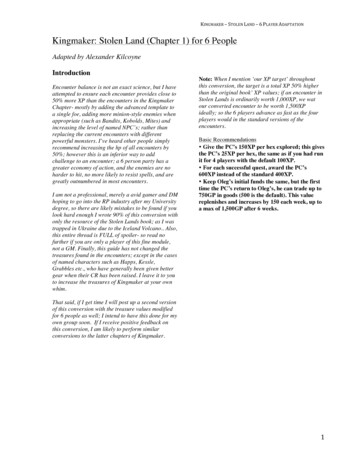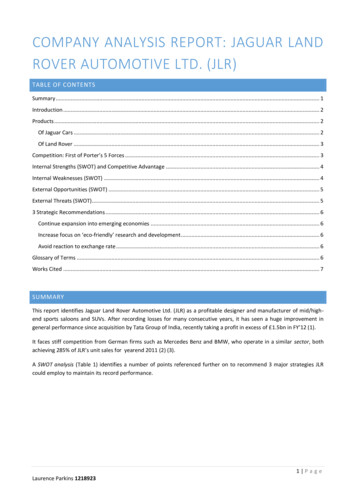
Transcription
COMPANY ANALYSIS REPORT: JAGUAR LANDROVER AUTOMOTIVE LTD. (JLR)TABLE OF CONTENTSSummary . 1Introduction . 2Products . 2Of Jaguar Cars . 2Of Land Rover . 3Competition: First of Porter’s 5 Forces . 3Internal Strengths (SWOT) and Competitive Advantage . 4Internal Weaknesses (SWOT) . 4External Opportunities (SWOT) . 5External Threats (SWOT) . 53 Strategic Recommendations . 6Continue expansion into emerging economies . 6Increase focus on ‘eco-friendly’ research and development . 6Avoid reaction to exchange rate . 6Glossary of Terms . 6Works Cited . 7SUMMARYThis report identifies Jaguar Land Rover Automotive Ltd. (JLR) as a profitable designer and manufacturer of mid/highend sports saloons and SUVs. After recording losses for many consecutive years, it has seen a huge improvement ingeneral performance since acquisition by Tata Group of India, recently taking a profit in excess of 1.5bn in FY’12 (1).It faces stiff competition from German firms such as Mercedes Benz and BMW, who operate in a similar sector, bothachieving 285% of JLR’s unit sales for yearend 2011 (2) (3).A SWOT analysis (Table 1) identifies a number of points referenced further on to recommend 3 major strategies JLRcould employ to maintain its record performance.1 P a g eLaurence Parkins 1218923
StrengthsWeaknessesOpportunitiesThreatsTakeover by Tata Motorshas boosted investmentpotential; 1.5bn by 2012(4)Half the performance peremployee of BMW as aresult of trade unioninfluence (5)Rapid growth of BRICeconomies such as China;at least 7% real annualGDP growth since 1999 (6)Few eco-friendly offeringsmeans rising fuel pricesmay adversely affect JLRsalesSuccessful new productse.g. Range Rover Evoque,51881 units sold by FY’12(7)Lost previous owner’s(Ford’s)relevantexperience in the sectorafter scious, loan of 340msecured to conduct R&D(8)Powerful trade unioninfluence in the UK hasproportionallygreatereffect on JLR efficiency tocompetitorsWeak pound boosts JLRexports, drives revenueincrease of 37% fromFY’11-‘12 (10)Foreign partnership mayweaken brand image;deter UK customersRailhead terminal hasincreaseddistributionpotential (9)Table 1: SWOT analysis outline3 recommended strategies identified are as follows: Continue expansion into emerging economies:o 2012 Cherry PPP is an example of successful implementation (11).o Potential to expand into India through Tata Motors Ltd.’s distribution channels.Increase focus on ‘eco-friendly’ research and development:o Become future fuels/eco-friendly automobile market pioneer (12) and exploit temporary monopolypower by leveraging government grants and investment by Tata Group.Avoid reaction to exchange rate:o Do not sacrifice up-market brand image to achieve a temporary revenue boost which will be ofnegligible long-term benefit.INTRODUCTIONThis report shall briefly analyse the market position and performance of Jaguar Land Rover Automotive Ltd. (JLR),owned by Tata Motors Ltd., a subsidiary of Tata group conglomerate (13). It should also present 3 key strategies toachieve the company’s objectives in the future. Distinctions between Land Rover and Jaguar Cars (the main 2subsidiaries of JLR) will be made where appropriate.PRODUCTSOF JAGUAR CARS“Jaguar Cars, founded in 1922, is one of the world’spremier manufacturers of luxury saloons and sportscars”, such as their latest car: the F-Type (Figure 1), to goon sale mid-2013 (14). Racing variants of most modelsare available, e.g. the XKR-S, allowing access to thelucrative performance car market with a sale price of 79,995 depending on configuration (15).Figure 1: Jaguar F-Type (16)2 P a g eLaurence Parkins 1218923
OF LAND ROVERThe Land Rover brand (which became a business entity in 1970) has long held a reputation for producing rugged anddependable off-road vehicles, such as the highly versatile Defender (Figure 2) (17). However, starting with the releaseof the Range Rover in 1970 they have expanded into the luxury SUV market (Figure 3), with the comprehensive off-roadability being an order winner to many despite it being unnecessary in most cases (18) (17).Figure 2: Land Rover Defender (19)Figure 3: Range Rover Evoque (20)COMPETITION: FIRST OF PORTER’S 5 FORCESIn general, vehicles produced by JLR fall into the luxurysaloon/sports car or luxury SUV categories. A number ofautomobile manufacturers compete almost directly with JLR inthese sectors, the largest of which are described in Table 2. Thesefigures represent the global oligopolistic market; there aremultiple region-specific variations. For example, in the USA,Chrysler serve as the primary competitor to JLR, with 43,000 unitssold compared with JLR’s 5,000 between Jan ‘12/’13 (21).CompanyUnit Sales 2011Sales Index(JLR 100)MercedesBenz1,380,000 (2)285BMW1,380,000 (3)285Audi1,370,000 (22)282JLR485,000 (23)100Volvo449,000 (24)92.6Porsche119,000 (25)24.5Table 2: Unit Sales for JLR's Competitors, '113 P a g eLaurence Parkins 1218923
INTERNAL STRENGTHS (SWOT) AND COMPETITIVE ADVANTAGE Since acquisition by Tata Motors Ltd. In 2008, JLR has been able to take advantage of the 77.7bn capitalreserves of Tata Group, as of March 2012 (26). Confidence in the JLR brands led to “a doubling of [thesubstantial initial] investment to 1.5billion” by Tata Motors Ltd. In February 2012, to finance development ofnew models and accelerate expansion into developing overseas markets, e.g. the BRIC economies (4). This hasled to greatly increased business performance, see Figure 4.The critically and commercially successful Range Rover Evoque (Figure 3), released 2011, has bolstered brandrecognition and proved to be the driving force behind the 33% Land Rover sales volume increase, see Figure 5.Railhead terminal at Castle Bromwich plant near Birmingham provides a direct, high capacity link toSouthampton Docks, facilitating rapid delivery of high volumes of units to overseas customers, saving “60million lorry miles” per year (9).400000000300000000Net Profit, 2000000001000000000-1E 08200720082009201020112012-2E 08-3E 08-4E 08Figure 4: JLR Net Profit, '07-'12 (5)FY'11FY'12FreelanderDefenderRange RoverDiscoveryOtherRange Rover EvoqueFigure 5: Land Rover Sales Composition, '11 & '12 (7)INTERNAL WEAKNESSES (SWOT) Low profit per employee compared with primarycompetitors, e.g. Mercedes Benz, see Table 3. Thishighlights inefficient use of available resources, hence lowproductive efficiency.Tata Motors Ltd.’s experience lies in small cheap cars andlarge commercial vehicles, so had little specific marketexpertise to offer JLR upon purchase.CompanyProfit per EmployeeFY’11, (5)MercedesBenz177,000BMW146,000JLR73,000Table 3: Profit per employee of JLR's 2 main competitors4 P a g eLaurence Parkins 1218923
EXTERNAL OPPORTUNITIES (SWOT)ExceptionalChinesemacro-economicgrowth is a strongprospect for continuedexpansionofthecompany, with highannualrealGDPincreases (see Figure 6)drivingconsumerspending power andconfidence. JLR sales inChina are already up76% for FY’12 thanks toestablishment of 201NSCs.14Real GDP Growth Rate, % 12108642099000203040506070809101112YearFigure 6: Real Chinese GDP Growth, '99 - '12 (27) Exploit shift in consumer values towards ‘eco-friendly’ cars, a sector which is likely to dominate the automotiveindustry in the future as fossil fuel reserves are depleted. The European Investment Bank granted a loan of 340m to fund R&D to tackle this issue in their products (8).“A favourable exchange environment” has increased product demand and revenue (up 37% from FY’11) (7)(10). This is an opportunity for JLR to increase its foreign market share.EXTERNAL THREATS (SWOT)Present lack ness120.00and persistent100.00fuelcostincreases (see80.00Figure 7) a60.00threat to JLR.Further40.00increases may20.00compel eventhe0.00predominantly02030405high-earningJLR consumerbase to migratefrom JLR.Partnership with Chery Automotive could diluteperception of the classic British heritage of JLR, whichis a primary USP especially in the UK market.Price Per Litre, 06070809101112YearFigure 7: Petrol Prices, '02 - '12 (8)CountryEmployees inunion, %UK27Germany19Table 4: Trade Union Membership Rates (28)5 P a g eLaurence Parkins 1218923
3 STRATEGIC RECOMMENDATIONSCONTINUE EXPANSION INTO EMERGING ECONOMIESIt is imperative that JLR treats growth in the BRICeconomies as an opportunity, or its competitors willswiftly establish a dominant market position. The 2012PPP with Chery Automobile (Figure 8) (a Chinese stateowned corporation) is an effective implementation of thisstrategy (29). Circumvention of state protectionist policiessuch as the large import tariff on foreign vehicles of atleast 25% ( 17% VAT) depending on engine size is nowpossible (27). The powerful engines present in most JLRmodels may have otherwise taken prices abovecompetitive levels.There is potential to utilise Tata Motors Ltd.’s establisheddistribution channels within India, which should be utilisedshould rapid expansion into India be deemed prudent,likely as a reaction to movement by a competitor.Figure 8: Chery Logo (30)INCREASE FOCUS ON ‘E CO-FRIENDLY’ RESEARCH A ND DEVELOPMENTAs JLR’s primary competitors have so far failed to claim a significant share of the ‘eco-friendly’/future fuel auto market,this is a great opportunity for JLR to implement a market pioneer strategy (12). Implementation will have lowuncertainty because alternative fuels will eventually become entirely necessary, and the creation of a temporarymonopoly will lead to supernormal profits in the short-term, depending on speed of reaction by competitors.JLR should establish a technological advantage by channelling available resources to R&D of future fuels and ‘ecofriendly’ cars, such as the C-X75 concept, which investigates an electric jet propulsion system (31).AVOID REACTION TO EX CHANGE RATEThe favourable exchange environment for JLR (1 GBP 9.68 CNY) (32) is reducing the price of JLR’s exports, and as aluxury, up-market brand, JLR products have an elastic PED ratio. Theoretically price should be lowered to stimulatedemand and increase revenue and market share. However, a large opportunity cost would be incurred in this situation:there is a risk of damaging the strong brand image possessed by JLR; currently a product differentiator. Therefore areduction in (the already reduced) price should be avoided.GLOSSARY OF TERMSA favourableexchangeenvironmentBRIC EconomiesWeakening of GBP compared with local currencies of major target marketsAcronym for the emerging economies of Brazil, Russia, India and ChinaConglomeratecorporation consisting of several companies in different businessesDifferentiatorSee USPMarket PioneerMonopolyCompany that takes the risk of being first to introduce a product into a market or sectorDefinition of monopoly: A situation in which a single company owns all or nearly all of the6 P a g eLaurence Parkins 1218923
market for a given type of product or serviceNSCsOligopolyOpportunity CostNational Sales CompaniesA market dominated by a small number of participants who are able to collectively exert controlover supply and market pricesThe cost of passing up the next best choice when making a decisionOrder WinnerThe feature or selling point that makes a consumer choose a given firm's product over acompetitorsPED ratioResponsiveness of demand of a good to a change in price. A ratio of 1 is inelastic, 1 iselasticPPPProductiveEfficiencyPublic Private Partnership: public and private sectors working togetherWhen all resources are being fully utilised to minimise average cost per unitProtectionistPoliciesWhen a government legislates against foreign firms to
A SWOT analysis (Table 1) identifies a number of points referenced further on to recommend 3 major strategies JLR could employ to maintain its record performance. 2 P a g e Laurence Parkins 1218923 Strengths Weaknesses Opportunities Threats Takeover by Tata Motors has boosted investment potential; 1.5bn by 2012 (4) Half the performance per employee of BMW as a result of trade union .
